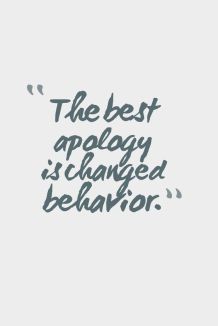
Never underestimate the value of a sincere apology.
If you don’t give a crap about the person, I guess you can say whatever you want. But a sincere apology goes a long way if you’ve hurt someone you care about and really want to make amends. If you get into arguments with loved ones where there is no clear resolution, it’s probably because they don’t end with a sincere apology, and therefore it’s difficult to reconnect.
Before I outline what to say in an apology, let me first begin with what not to say. Things that will likely prolong the argument and hurt the relationship.
Insensitive comments have to do with shame–the feeling that, if you make a mistake, you must be a bad person. Therefore, the person cannot acknowledge any wrongdoing. And because the person is focused on their own shame for making a mistake, they cannot have compassion for the person who they have hurt. Here are some examples:
- You’re too sensitive. This is not an apology at all, obviously. You’re basically saying it’s not me; it’s you. You are flawed. I am not.
- That wasn’t my intention. I meant well. Not my fault if you interpreted my good intentions in a different way. So we can just agree to disagree and you need to get over it.
- Everyone has flaws. You know how I am. I have a bad temper. Sometimes I blow up. I can’t change who I am. So expect more of the same.
- I’m sorry that you’re upset. I can see you’re upset, but I don’t take any responsibility for it. But I do I wish you weren’t upset, because you’re upsetting me.
- I’m sorry. I will say sorry to appease you, but I have no idea what you’re upset about. And I don’t really want to try to find out and have to change my behavior.
If you have said one or more of these things, let me reiterate that you are not a bad person. No one likes making mistakes. It activates our defenses and makes us want to protect ourselves rather than attend to the other person. And most of us aren’t taught how to give a sincere apology.
So here’s your chance to change your behavior. These are the steps you can take when you’ve hurt someone:
- Acknowledge their pain. Even if you think they’ve misunderstood what you’ve said or done. Try to identify what they’re feeling. Acknowledge that you can see how your actions triggered that feeling.
- Tell them that you care about their feelings. Let them know that their pain matters. You do not want to be the cause of their pain because you love this person, and it hurts you to know that you have been, in this case.
- Make your apology specific. I’m sorry that I worried you by not letting you know I was running late. I’m sorry that I made it sound like it’s your fault, when it’s not.
- Make a commitment to change your behavior. From now on, I’ll text you if I’m running late. I’ll tell you that I need space and tell you when I’ll call back rather than hang up.
- Reaffirm your commitment to the person. I care about you and I care about our relationship. I’m going to demonstrate this through my actions.
The best way to practice giving sincere apologies is to practice self-compassion. When you accept your own mistakes and forgive yourself for making them, you learn that making mistakes doesn’t make you a bad person. We all make them. We’re all just stumbling along, not knowing what we’re doing half the time.
So self-forgiveness goes a long way.
Ironic, isn’t it? That the best way to learn how to be kind to others is to be kind to ourselves? That’s a win-win, if you ask me.






Great read! As someone who is very rough around the edges, I’ve had to learn all these steps the past few years. You’ve nailed it.
LikeLiked by 1 person
Thanks Stephen!
LikeLike
Excellent post… This should be spread far and wide
LikeLike
Thanks!
LikeLike